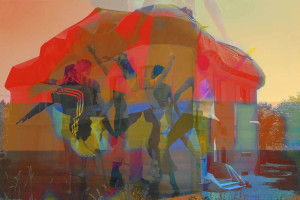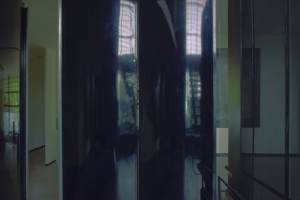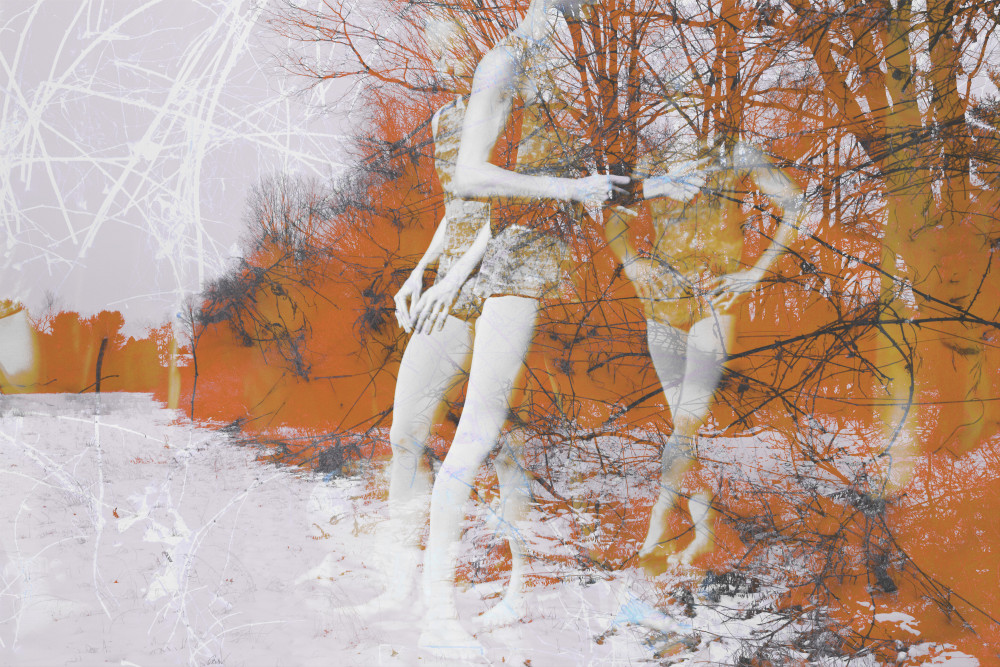It is impossible to do justice to a show of the scope, ambition and sheer beauty of James Welling’s current exhibition of recent work at Regen Projects in a single blog post. But it would be no less impossible and even irresponsible to let it go without some acknowledgment in this space. Choreograph reaches back to Welling’s deepest roots as an artist, and beyond that to the roots of modernism, abstraction, and photography itself. To those of us for whom Merce Cunningham’s choreography and dancing amounted to a new grammar or grammatology for approaching not simply dance and movement, but contemporary language and communication, culture and society, modernism and contemporary art, the show will be deeply resonant. It was Cunningham who inspired Welling to study dance at the University of Pittsburgh. Only a year later, his focus would shift decisively to photography at CalArts; but as with so many of us, that inspiration left an enduring mark.

0321, 2015; inkjet on rag paper (106.7 x 160 cm) Courtesy the artist and Regen Projects, Los Angeles
At a press preview last Friday, Welling also mentioned his photography at the Glass House, Philip Johnson’s iconic residence and estate in New Canaan, Connecticut, and the equally iconic 1932 Maison de Verre of Pierre Chareau and Bernard Bijvoet (in collaboration with master craftsman Louis Dalbet), originally built as the combined medical office and residence of Dr. Jean Dalsace in Paris. The parallels with Welling’s Glass House photography, with its vivid colors, flares and swaths of landscape are fairly pronounced. But to my mind, the Maison de Verre photographs (almost reticently hung in Regen’s West Hollywood space in 2012), however straightforward and minimally manipulated, may be the stronger point of departure here. For all the impassive urban sequestration of its 18th century courtyard siting, the Chareau/Bijvoet Maison, with its glass block walls, its shifting screens and concealed/revealed staircase, various moving parts, utilities and accessories, is a structure in subtle but continuous motion under its shifting lights; a study in shifting composition, perspectives, spatial relationships and architectural movement. Chareau’s plot for the structure was borne out of a contemporary machine aesthetic, but its implications were far-reaching. There are distant echoes here of the contingent phrasing, continuous shaping and reshaping (and disjunction, disruption and drama) so essential to Cunningham and really all of contemporary dance.

James Welling, MDV 9205 (2009) from Maison de Verre series; dimensions uncertain; Courtesy the artist and Regen Projects, Los Angeles
As if to counterpoint this transparency, mutability and contingency, Welling has shifted his architectural plot points beyond the modern classicism of Chareau/Bijoet and Mies van der Rohe to the later mid-century brutalist or quasi-brutalist architecture of Paul Rudolph and Marcel Breuer with its pronounced concrete massing and unapologetically formalist, unambiguous proportions and spatial relations, which propose an entirely different relationship with both landscape and the bodies that move through it. In a sense, the body’s movement is an implicit interrogation of such structure, its fixed lines and coordinates, its imposed flow; with that same fixity challenged by the mutable landscape, its changes both seasonal and more subtle. There are foreshadowings of this in some of the Glass House photographs, especially those interior exposures – with now fragile-looking accessories dissected by patches of landscape and reflections of bright bare trees skewing intrusively into the space. Then there’s the not-so-small irony of such buildings’ incongruous fragility – here most notably, the Orange County government seat designed by Paul Rudolph, now already vandalized beyond recognition. There is a poignancy to the glimpses of that building’s distinctively corrugated façade with its thrusting rectilinear projections.

7690, 2015; inkjet on rag paper (106.7 x 160 cm) Courtesy the artist and Regen Projects, Los Angeles
That spectral, almost dream-like, aspect – of dancers and landscape details, as well as architecture – is emphasized by the color – here executed entirely in Photoshop using the RGB color channels with additional ‘gestural’ manipulations and and adjustments made using the Adobe Paintbrush tool. The windows flare orange-red, undulant with interior reflections in ghostly-white negative; with orthogonally projecting lines alternately in negative purples and cyans and acid-yellows and bright greens – all pointing to the denatured nature of the landscape. (In one such print, 7690 (2015) – they’re all inkjet prints – the forward-falling movement of the superimposed dancers emphasizes the entire rightward tilt of bright, imminent collapse.) Welling provided a very helpful guide to how the images were layered in the red, green and blue Photoshop channels. This amounts to an inversion of his procedure with his Glass House photographs, in which he was using color filters with the camera, now achieving the entire color filtration, painting and shadowing of the imagery through digital manipulation and adjustments. But here, as in so much of Welling’s recent work – whether deliberately abstracted photogram imagery or more straightforward photography complicated by multiple angles, exposures, reflections – we see the same tension between the insistent transparency and an equally insistent will to abstract that again returns us to the terrain of modern and contemporary dance. (Welling photographed a dozen dance companies in New York, Los Angeles, Philadelphia and Ottawa, including Lucinda Childs, Martha Graham, and Stephen Petronio (who has worked notably with another Regen artist, Anish Kapoor), as well as the Cunningham company, to produce the images.) Where choreography maps movement in real time and space, though, Welling is reaching into the RPG receptor space behind lens and retina – where the way we see it parallels the way we ‘say’ it, where disquieting juxtapositions and discomfiting confrontations morph into the stuff of sublime epiphanies.
I realize that I’ve given some emphasis in these notes on the architecture, but the layered imagery impresses seamlessly in these prints. (I think it’s also important to draw attention to their fragmentation.) The body is itself an ‘architectural’ element in these images; the landscape no less a part of their ‘dramatics.’ It would be oversimplifying to call color the ‘music’ that completes this complex choreography of action, atmosphere and abstraction – but it satisfies that function, too. Whether drawn from the natural or the digital domain, color crosses the functional divide of transparency and abstraction – transposing light, interiorizing space, filtering affect; addressing finally the further reordering and reconstitution that will unfold continuously behind the viewer’s own eye and lens.



















0 Comments